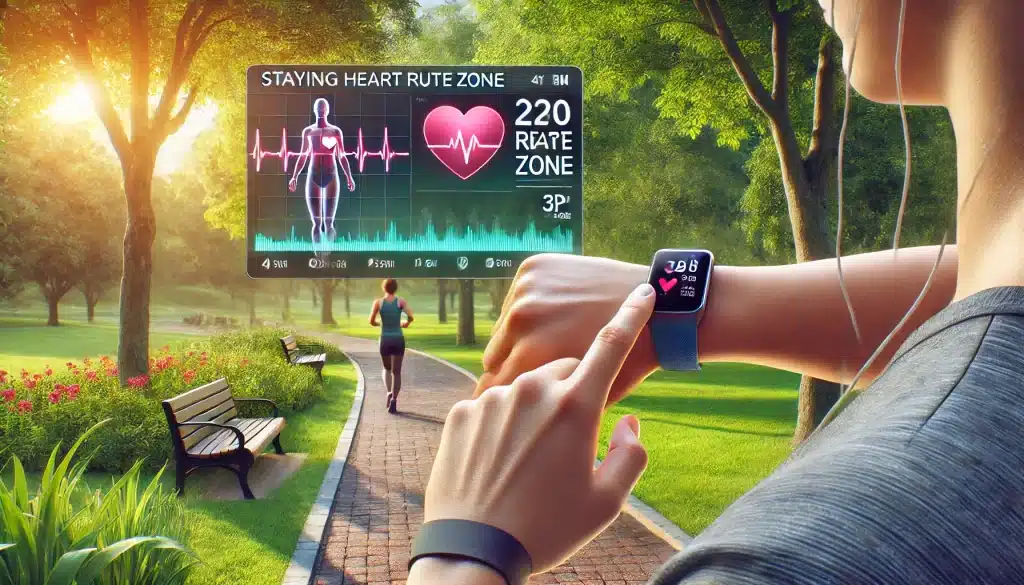Understanding Heart Rate Zones
When it comes to cardiovascular fitness, understanding heart rate zones is crucial for exercising safely and efficiently. Heart rate zones help you measure the intensity of your workout, ensuring you stay within a safe range while maximizing the benefits for your heart health. By knowing your heart rate zones, you can tailor your exercise routine to meet specific fitness goals and improve your overall health.
![]()
Heart rate zones are typically calculated based on a percentage of your maximum heart rate, which varies depending on your age and fitness level. These zones range from very light activity to maximum effort, each serving a different purpose in terms of endurance, fat burn, and cardiovascular improvement. It’s essential to understand these zones to exercise safely and avoid overexertion, which could harm your heart.
- Heart Rate Zones help regulate exercise intensity.
- These zones are based on a percentage of your maximum heart rate.
- Working within the correct zone maximizes heart health benefits.
Why Heart Rate Matters in Exercise
Understanding why your heart rate matters during exercise is key to optimizing your workouts. Your heart rate directly reflects the intensity of the exercise you’re doing and how much effort your body is exerting. Keeping track of your heart rate zones allows you to train more effectively, helping you to reach fitness goals faster and improving overall heart health.

Exercising within the correct heart rate zone ensures that your body is burning the right amount of energy and avoiding unnecessary strain. For those looking to improve endurance, build strength, or lose weight, monitoring heart rate zones can help you stay in the optimal range for fat burning or cardiovascular conditioning.
- Your heart rate indicates exercise intensity and effort.
- Tracking heart rate zones helps you stay in a safe and effective exercise range.
- It optimizes your workouts and protects your heart health.
How to Calculate Your Heart Rate Zones
Calculating your heart rate zones is relatively simple, but it requires knowing your maximum heart rate first. The most common method to calculate your maximum heart rate is the formula: 220 minus your age. Once you have your maximum heart rate, you can determine your heart rate zones by calculating percentages of that number.

There are typically five heart rate zones, ranging from light activity to maximum effort, and each zone corresponds to a specific level of intensity. These zones are often defined as a percentage of your maximum heart rate, which helps tailor your exercise based on fitness goals.
- Use the formula 220 minus your age to calculate your maximum heart rate.
- Heart rate zones are percentages of your maximum heart rate.
- Understanding these zones helps structure your workouts effectively.
Maximum Heart Rate
Your maximum heart rate is the upper limit of what your cardiovascular system can handle during physical activity. It serves as the baseline for calculating your heart rate zones and determining the intensity of your workouts. This number decreases with age, so it’s essential to use the appropriate formula for accurate calculation.
While the basic formula of 220 minus your age is widely used, keep in mind that individual fitness levels and genetics can also affect your maximum heart rate. For more precise measurements, you can consult a healthcare professional or use specialized fitness tracking devices.
Target Heart Rate Zones
Your target heart rate zone is the range you want to maintain during exercise to achieve specific fitness goals. These zones typically fall between 50-85% of your maximum heart rate, depending on your fitness objectives. Training within your target heart rate zone ensures you get the most out of your workout while avoiding overexertion.
For example, if you aim to improve cardiovascular endurance, you might train in the lower heart rate zones. However, if you’re focusing on high-intensity interval training (HIIT), you would spend more time in the higher zones. Tailoring your workouts to your heart rate zones is crucial for both safety and progress.
- Your target heart rate zone is the ideal range for maximizing workout benefits.
- This range is typically between 50-85% of your maximum heart rate.
- Training within this zone helps you achieve specific fitness goals.
Different Heart Rate Zones and Their Benefits
Each heart rate zone serves a different purpose for your overall fitness and heart health. These zones, typically divided into five categories, help guide your exercise routine and ensure you’re working at the right intensity for your specific goals. Whether you’re aiming for fat loss, cardiovascular improvement, or high-performance training, understanding the benefits of each heart rate zone is essential.

Below, we’ll break down the five heart rate zones and the benefits each offers. These zones are based on a percentage of your maximum heart rate, ensuring that you train safely and efficiently within your capabilities.
Zone 1: Very Light (50-60% of Max HR)
The first zone, known as the “very light” zone, is where you exercise at a very low intensity, typically 50-60% of your maximum heart rate. This zone is ideal for warm-ups, cool-downs, and recovery sessions, allowing your body to adjust to physical activity without overexertion. While it doesn’t offer the same cardiovascular benefits as higher zones, it’s crucial for building endurance and maintaining heart health.
- This zone is perfect for warm-ups and recovery periods.
- It helps improve blood circulation and prepares your body for more intense exercise.
- Training in this zone aids in building overall endurance without straining the heart.
Zone 2: Light (60-70% of Max HR)
In the “light” zone, you’re exercising at 60-70% of your maximum heart rate. This zone is often associated with fat burning, as your body relies more on fat stores for energy at this intensity. It’s also ideal for longer-duration exercises, such as walking or light jogging, where you can sustain activity for an extended period while improving cardiovascular endurance.
Zone 2 is highly recommended for beginners, as it strikes a balance between safety and effectiveness. It helps build a strong cardiovascular foundation and promotes consistent fat loss when done regularly.
- Great for fat-burning exercises and low-intensity cardio.
- Helps build stamina and improve long-term heart health.
- Works well for sustained, long-duration exercises like walking or light jogging.
Zone 3: Moderate (70-80% of Max HR)
Zone 3, or the “moderate” intensity zone, is where your heart rate is between 70-80% of its maximum. This is where you start to feel the workout becoming more challenging, but it remains manageable. Exercises in this zone improve your aerobic capacity, which is essential for enhancing endurance and overall cardiovascular function.
This is the zone where many people spend most of their workout time, as it strikes a balance between burning calories and improving heart health. It’s especially effective for those looking to improve their overall fitness level and endurance.
- Improves aerobic capacity and cardiovascular efficiency.
- Great for moderately intense workouts that challenge the heart and lungs.
- Helps improve endurance and overall fitness levels.
Zone 4: Hard (80-90% of Max HR)
In Zone 4, also known as the “hard” zone, you’re pushing your body to work at 80-90% of its maximum heart rate. This zone is often used for high-intensity interval training (HIIT) and shorter bursts of intense activity. Training in this zone increases your anaerobic threshold, meaning you can work harder for longer without fatiguing as quickly.
However, it’s essential to limit the time spent in this zone to avoid overexertion. While Zone 4 provides significant cardiovascular benefits, it can be taxing on your heart if done too frequently without adequate recovery.
- Boosts anaerobic threshold and improves high-intensity performance.
- Helps in developing strength and speed.
- Should be used for short, intense workout intervals.
Zone 5: Maximum Effort (90-100% of Max HR)
Zone 5 is the most intense heart rate zone, where you’re working at 90-100% of your maximum heart rate. This zone is typically reserved for athletes or those undergoing very intense training. Exercises in Zone 5 push your body to its limits, improving your peak performance, speed, and power. However, this zone should be approached with caution, as it can quickly lead to exhaustion or injury if not monitored carefully.
It’s crucial to only spend short bursts of time in Zone 5, allowing for adequate recovery in lower zones between high-intensity intervals. Training in this zone provides significant fitness gains but should be done sparingly to avoid overloading your heart and body.
- Maximizes performance gains in speed, power, and strength.
- Should only be used for short intervals with adequate recovery.
- Requires a strong fitness base to train safely at this intensity.
How to Monitor Your Heart Rate During Exercise
Monitoring your heart rate during exercise is essential to ensure you’re training within the appropriate heart rate zones for your goals and safety. There are several methods available, ranging from manual pulse checking to high-tech fitness trackers. Regardless of the method, understanding your heart rate during exercise allows you to adjust intensity levels and avoid overexertion, which is crucial for protecting your heart health.

For those new to heart rate monitoring, wearable devices such as chest straps, wrist-based heart rate monitors, or smartwatches are ideal for providing real-time feedback. These devices track your heart rate throughout the workout and alert you when you move out of your target heart rate zone, allowing you to adjust your effort accordingly. You can also manually check your pulse during breaks to ensure you’re staying within your desired range.
- Wearable devices like chest straps and smartwatches offer real-time heart rate tracking.
- Manually checking your pulse during exercise is a simpler, no-tech method.
- Accurately tracking your heart rate helps you adjust exercise intensity for optimal heart health.
Safety Tips for Exercising in Different Heart Rate Zones
Exercising within the right heart rate zone can enhance your fitness and overall health, but it’s essential to do so safely. Overexertion can lead to injuries or cardiovascular strain, especially if you’re consistently working in the higher heart rate zones. To avoid these risks, it’s crucial to listen to your body and make sure you’re working within your limits, gradually increasing intensity over time.

Here are some key safety tips for exercising in different heart rate zones:
Zone 1 and Zone 2 (Very Light to Light)
In these lower intensity zones, the risk of injury or overexertion is minimal. However, it’s still important to maintain proper form and avoid staying too long in these zones if you’re aiming for specific fitness improvements, as prolonged low-intensity exercise can limit your progress.
- Focus on maintaining good form, even at lower intensities.
- Ensure you use these zones primarily for recovery or long-duration cardio.
Zone 3 (Moderate)
Zone 3 is generally safe for most individuals, but it’s still important to monitor how your body feels. While moderate exercise is beneficial for building endurance and heart health, overdoing it can still lead to fatigue or overtraining. Gradually increase your intensity and give your body time to adapt.
- Listen to your body and avoid pushing through significant fatigue.
- Gradually increase duration and intensity over time to prevent overtraining.
Zone 4 and Zone 5 (Hard to Maximum Effort)
These higher intensity zones require careful monitoring. Spending too much time in these zones can lead to muscle fatigue, cardiovascular strain, or even injury. Always warm up thoroughly before attempting high-intensity training, and ensure that you allow adequate recovery between sessions.
- Warm up properly before engaging in high-intensity exercises.
- Limit time in these zones to avoid overexertion and injury.
- Incorporate recovery periods to prevent cardiovascular strain.
Common Mistakes to Avoid When Exercising for Heart Health
While exercising in your target heart rate zone is an excellent way to improve fitness and heart health, there are common mistakes that can hinder your progress or even put you at risk. Avoiding these mistakes will ensure you stay on track toward your fitness goals without jeopardizing your well-being.

- Not monitoring heart rate: Failing to track your heart rate can lead to working out either too hard or not hard enough, limiting the effectiveness of your workouts.
- Skipping warm-ups and cool-downs: Jumping straight into high-intensity exercise without properly warming up can cause injury and strain on the heart.
- Ignoring recovery: Consistently exercising at high intensities without giving your body time to recover can lead to overtraining and increased risk of injury.
Benefits of Exercising in the Right Heart Rate Zone
Exercising within your ideal heart rate zone offers numerous benefits for both fitness and overall heart health. By targeting the appropriate heart rate zones, you can ensure that your body is working efficiently, helping you achieve your fitness goals faster and more safely. Understanding the benefits of each heart rate zone will enable you to tailor your workouts to maximize your performance and improve your cardiovascular system.

Here are some of the key benefits of staying within the right heart rate zones during your workouts:
- Improved cardiovascular health: Regularly exercising in your target heart rate zone strengthens your heart, making it more efficient at pumping blood throughout your body. This helps lower your risk of heart disease and other cardiovascular conditions.
- Fat burning and weight loss: When you exercise in the lower heart rate zones, particularly Zone 2, your body primarily burns fat for fuel. This makes it an effective way to lose weight and improve body composition.
- Increased endurance and stamina: Training in moderate-intensity heart rate zones (Zone 3) builds aerobic capacity and endurance, allowing you to exercise for longer periods without fatigue.
- Enhanced performance: High-intensity zones (Zone 4 and 5) help improve speed, strength, and overall athletic performance by pushing your body to work at its maximum capacity.
- Better recovery: Exercising in lower heart rate zones during recovery days helps your body repair and regenerate without overexertion, promoting faster recovery between intense workouts.
Conclusion: How to Stay Safe and Maximize Heart Health Benefits
Understanding and utilizing your heart rate zones effectively is a powerful tool for optimizing your exercise routine and improving your overall heart health. By staying within your target heart rate zone, you can avoid overexertion, maximize fat burning, and improve cardiovascular endurance. Whether you’re new to fitness or an experienced athlete, monitoring your heart rate will help you exercise more efficiently and safely.

Remember, it’s essential to listen to your body, warm up before intense workouts, and incorporate recovery days into your routine. This approach will not only protect your heart but also enhance your fitness results over time. By focusing on your heart rate zones, you can ensure that each workout session is both safe and effective, contributing to a healthier and stronger heart.
- Stay within your target heart rate zones to optimize workout efficiency and safety.
- Incorporate recovery days to allow your heart and body to recover.
- Focus on long-term, sustainable improvements in your cardiovascular health and fitness.
FAQs: Exercising Safely with Heart Rate Zones
What is the best heart rate zone for fat burning?
The best heart rate zone for fat burning is typically Zone 2, where your heart rate is 60-70% of your maximum heart rate. In this zone, your body primarily uses fat as fuel, making it ideal for sustained fat loss and endurance training.
Can I exercise in the maximum heart rate zone every day?
No, exercising in the maximum heart rate zone (90-100% of your maximum heart rate) should not be done every day. This zone is for short bursts of high-intensity activity, and overexerting yourself can lead to injury or cardiovascular strain. It’s important to balance high-intensity workouts with recovery.
How do I know if I’m in the right heart rate zone?
Using a heart rate monitor, fitness tracker, or manually checking your pulse can help you stay within the correct heart rate zone. Many wearable devices can alert you when you move out of your target zone, allowing you to adjust your intensity accordingly.
Why is it important to monitor my heart rate during exercise?
Monitoring your heart rate ensures that you’re exercising within a safe intensity level. It helps you avoid overexertion, ensures you’re training effectively, and protects your heart health while allowing you to reach your fitness goals more efficiently.
How can heart rate zones improve my workout results?
Training within specific heart rate zones allows you to target particular fitness goals, such as fat loss, endurance, or performance enhancement. By working within your ideal zone, you can optimize your workouts and achieve better results while minimizing the risk of injury or overtraining.



